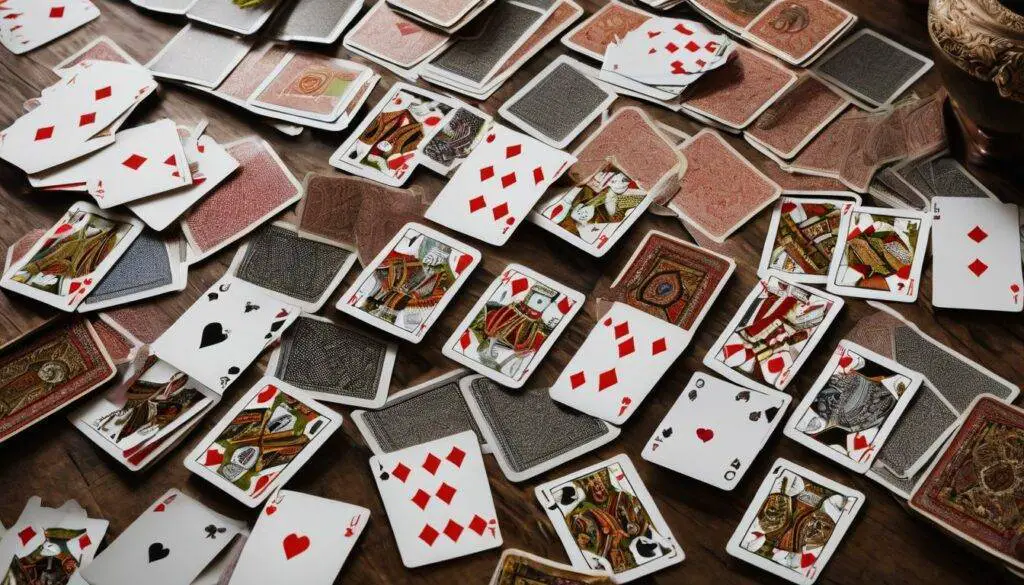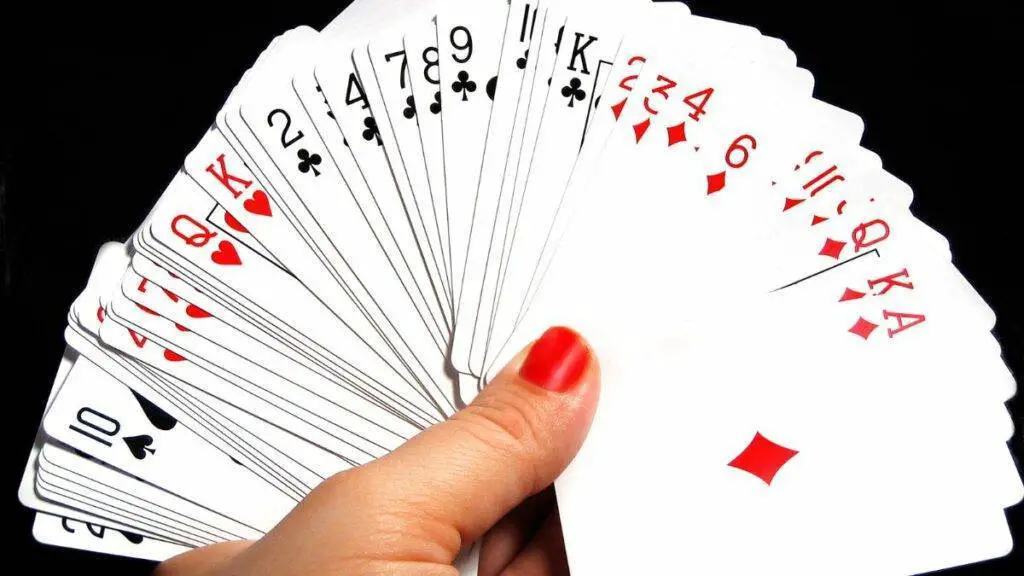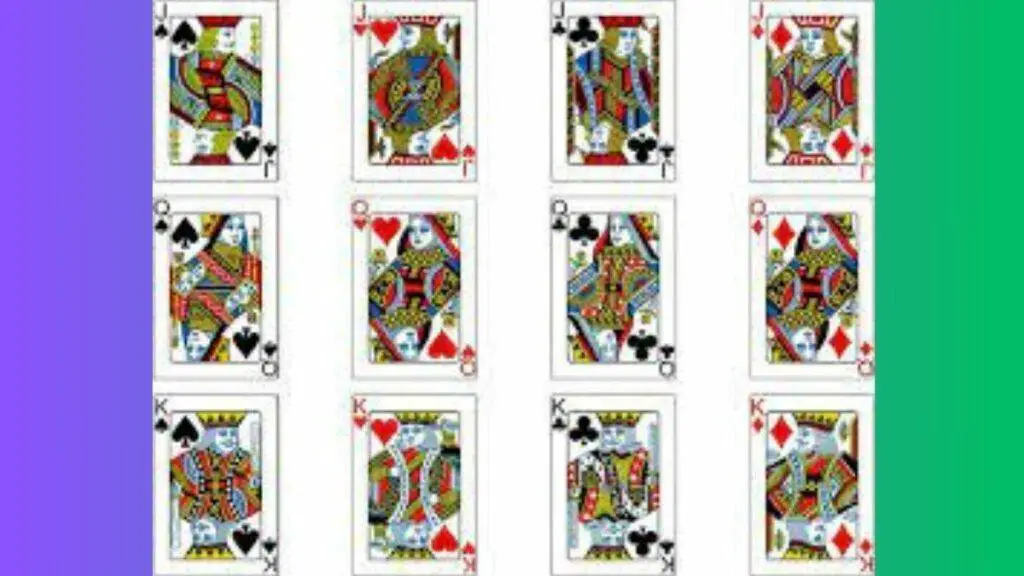Ever found yourself pondering just how many face cards reside in a deck of cards? I must confess, this question often occupied my thoughts, especially during those marathon poker nights with buddies.
Once I started digging into the intriguing world of playing cards, it became apparent that these little pieces of paper hold more mystery and wonder than one might initially think! In this article, we’re about to unravel the numbers and roles of face cards in a standard deck – so you won’t have to pause mid-game with a puzzled expression ever again.
Are you ready for an enlightening adventure through the Kingdoms of Kings, Queens and Jacks?.
Key Takeaways
- In a standard deck of cards, there are 12 face cards in total – 4 each of the King, Queen, and Jack.
- Face cards do not have numerical values like the other cards but represent important characters from different cultures.
- The probability of drawing a face card from a shuffled deck is approximately 23%.
Understanding Face Cards in a Deck of Cards

Face cards in a deck of cards are the King, Queen, and Jack. There are 12 face cards in total in a standard deck.
Definition and types of face cards (King, Queen, Jack)
Face cards are a big part of a card deck. They are the King, Queen, and Jack. In every suit like clubs or hearts, there is one of each face card. These cards used to be known as court cards long ago.
Each face card shows a figure with two faces looking both ways. It makes them stand out from other numbered cards in the deck that just show numbers and shapes.
Quantity of face cards in a standard deck (12 face cards in total)
In a standard deck of cards, there are 12 face cards in total. These face cards include the Jack, Queen, and King in each of the four suits: clubs, hearts, spades, and diamonds. Each suit has one face card, which makes it a total of three face cards per suit.
These face cards do not have numerical values like the rest of the cards in the deck but represent special characters with unique roles in various card games.
Exploring the Breakdown of Face Cards
Each suit in a standard deck of cards contains four face cards – the King, Queen, and Jack.
Number of each face card per suit (4 Kings, 4 Queens, 4 Jacks)
In a standard deck of cards, there are 4 Kings, 4 Queens, and 4 Jacks. That’s one for each of the four suits: clubs, diamonds, hearts, and spades. Here’s a simple table that shows the distribution:
| Face Card | Club | Diamond | Heart | Spade |
|---|---|---|---|---|
| King | 1 | 1 | 1 | 1 |
| Queen | 1 | 1 | 1 | 1 |
| Jack | 1 | 1 | 1 | 1 |
You might be seeking a job now, but don’t overlook the significance of these 12 face cards. They were previously known as court cards and are often depicted with reversible (double-headed) images. They add a level of visual interest and complexity to many card games, which could be a fun talking point in a team-building exercise or even a job interview.
Significance and symbolism of face cards in playing card history
The face cards in a deck of playing cards have significant importance and symbolism in the history of card games. These cards, namely the King, Queen, and Jack, represent important figures or characters from different cultures.
They were originally known as court cards because they depict royal members or individuals associated with noble positions. The face cards add visual interest and complexity to various card games and are often depicted with reversible images, allowing for versatile gameplay options.
Their unique design and representation make them an integral part of playing card history that continues to be celebrated in popular card games today.
Other Cards in a Deck

Non-face cards in a deck include numbered cards and Aces, which have different values within a standard deck of playing cards.
Non-face cards (numbered cards and Aces)
The non-face cards in a standard deck of playing cards are the numbered cards and Aces. Unlike the face cards, which represent the Jacks, Queens, and Kings, these cards have numerical values.
In each suit (clubs, hearts, spades, and diamonds), there are nine numbered cards that range from 2 to 10. Additionally, there is one Ace in each suit. The Aces can be considered as either low or high depending on the card game being played.
So in total, there are 36 non-face cards – nine numbered cards and four Aces – in a standard deck of 52 playing cards.
Different suits and values within a standard deck
In a standard deck of cards, there are four different suits: clubs, hearts, spades, and diamonds. Each suit contains 13 cards in total. The numbered cards range from 2 to 10 and have their respective values. However, the face cards in a deck do not carry numerical values like the rest of the cards. Instead, they have special names and roles. The face cards consist of the Jack, Queen, and King in each suit. So when playing card games or looking at a deck of cards, you will see these distinct faces representing the higher-ranking cards in each suit.
Probability and Mathematics of Face Cards

Calculating the probability of drawing a face card adds an element of excitement and strategy to card games.
Calculation of the probability of drawing a face card
The probability of drawing a face card from a standard deck of 52 cards is fairly straightforward. Since there are 12 face cards in total (four Jacks, four Queens, and four Kings), we can calculate the probability by dividing the number of face cards by the total number of cards in the deck.
So, the probability would be 12 divided by 52, which simplifies to 3 divided by 13 or approximately 0.23 (or about 23%). This means that there’s about a one in four chance of drawing a face card from a shuffled deck.
Combinations and permutations involving face cards
When playing card games, it can be helpful to understand combinations and permutations involving face cards. Since there are 12 face cards in a standard deck (4 Kings, 4 Queens, and 4 Jacks), these special cards offer various possibilities in the game.
For example, if you’re wondering how many different combinations of two face cards you can have in a hand, it would be calculated using permutations. With 12 available options for the first face card and 11 remaining options for the second face card, there would be a total of 132 possible combinations.
These calculations can help you strategize and make informed decisions during gameplay.
Conclusion: The Fascination of Face Cards
Face cards in a deck of cards hold a special allure, adding excitement and strategy to various card games. From the intricate artwork to the intriguing symbolism, face cards have captured our fascination for centuries.
Impact of face cards on various card games
Face cards have a significant impact on various card games. They add an element of strategy and excitement to games like poker, blackjack, and casino. In these games, face cards hold special values and can determine the outcome of a hand.
For example, in poker, the King is considered higher than the Queen or Jack. The face cards also play important roles in creating winning combinations and determining the order of rank in different card games.
So whether you’re playing for fun or trying your luck at a casino, understanding the impact of face cards is key to enjoying these card games to their fullest potential.
Fun facts and trivia about face cards in decks
- The face cards in a deck of cards, also known as court cards, represent the cards numbered 11 to 13 in each suit.
- There are a total of 12 face cards in a standard deck, with one face card in each suit.
- Unlike the rest of the cards in the deck, the face cards do not have numerical values.
- The face cards are often depicted with reversible (double – headed) images, adding visual interest to the deck.
- In addition to their role in various card games, face cards have a historical significance and symbolism in playing card history.
